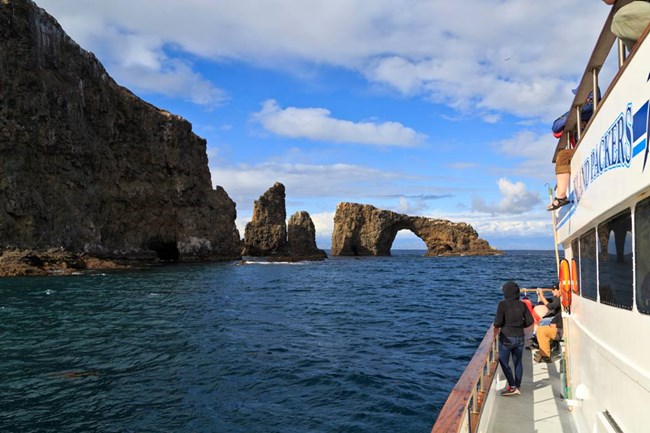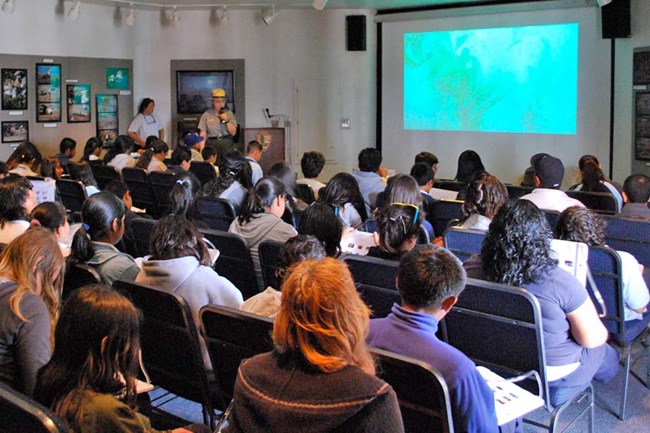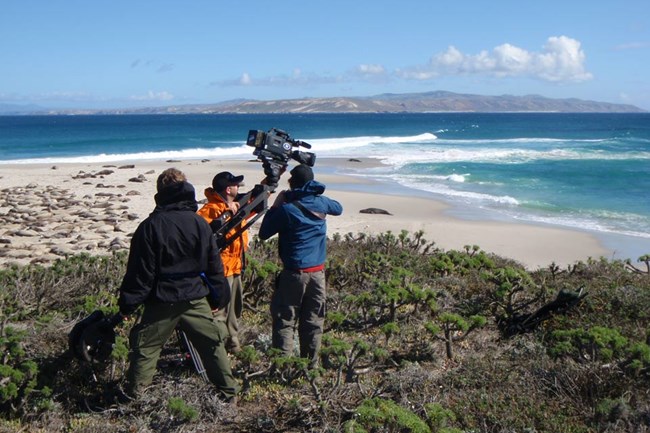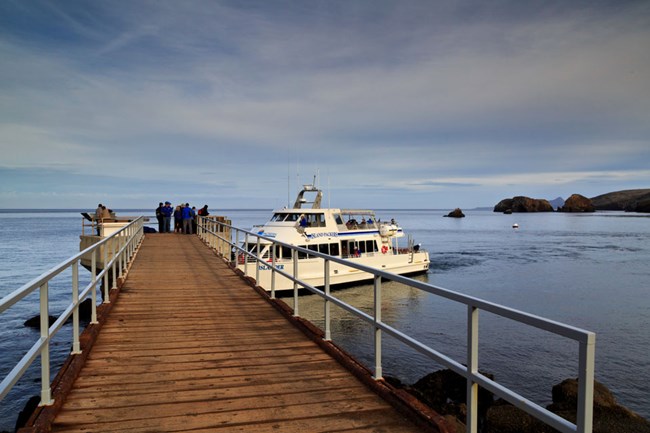
Tim Hauf, timhaufphotography.com
Education and Outreach
Both the national park and marine sanctuary support extensive educational and outreach programs that are designed to engage the public in stewardship of the marine protected areas. Targeted audiences for these programs include site visitors, local K-12 and college students, partner agencies, natural resource and travel-tourism commissions and councils, regional and national media markets, and international conservation communities. Classroom activities, visitor centers, wayside exhibits on coastal trails, evening public lecture series, web sites, and a series of periodic scientific conferences are all used to connect local and distant communities to natural and cultural resources in the marine protected areas.A volunteer-based Channel Islands Naturalist Corps trains community members to interpret marine protected area resources for other members of the public on tour boats and at a variety of island and mainland venues. Park and sanctuary management and technical staffs also participate as speakers at civic organizations in the region and at national conferences.
A particularly innovative and successful educational program, begun in 1983, is a live, interactive underwater video program called Channel Island Live. Divers in the Anacapa State Marine Reserve broadcast live from the kelp forests surrounding the island in order to allow visitors in the mainland visitors center to interact with the animals and plants on the sea floor. Since 2008, the programs have also been broadcast live over the internet to school classrooms around the world, through a partnership with the Ventura County Office of Education.
Another outreach program, pioneered at the Channel Islands in 1992, is the Great Annual Fish Count. Designed to engage communities in marine protected area stewardship, this annual population assessment conducted by recreational divers quickly became a national and then international program that continues to this day. These annual fish counts are conducted during the month of July, and the resulting survey data is published on a publicly accessible web site maintained by the Reef Environmental Education Foundation (REEF) in Florida. The annual and social nature of this program helps to focus community attention on and to remind people about the connection between the public and the marine protected areas.

NPS Photo
Public Involvement in Assessment
Both the national park and the national marine sanctuary have formal performance measures in place, which assure and inform the public that conservation and stewardship standards are being met. The park and the sanctuary each produce, review, and revise General Management Plans (GMP), which allows the public multiple opportunities to participate in setting management goals and objectives for these marine protected areas.The National Parks Conservation Association (a public organization) produces “State of the Parks” reports on parks within the National Park System, in order to evaluate how the parks are doing in terms of law and policy. The NPCA evaluated Channel Islands National Park in 2008, along with two other NPS units in the southern California area. These reports are based largely on an analysis of the available scientific literature and on interviews with park staff. They represent an independent, public, evaluation of marine protected area stewardship.
In addition to involving the public in performance assessment, the NPS also uses an academically-developed “money generation model” to evaluate the contribution of the park to local economies and job markets. This model indicated that in 2008, Channel Islands National Park visitors spent $29.7 million locally and that expenditures by non-local visitors (live >80 km from park) created 531 jobs and added $20.4 million in value to the local economy. Those figures were in addition to the park’s direct payroll for 85 jobs that generated 132 support jobs and a total of $7.9 million in secondary value to the local economy.

NPS Photo
Public Involvement in Designation Processes
Numerous public processes are used in marine protected area design and establishment that involve a wide variety of local, regional, national, and international communities of interest. These processes range from National Environmental Protection Act (NEPA)-driven management review to California Fish and Game Commission deliberations, public hearings, and designations.Public involvement can both encourage and discourage designation. Controversy over the 1969 Santa Barbara Channel oil well blowout is credited with contributing to the passage of the Marine Protection, Research, and Sanctuaries Act of 1972 that authorized designations of national marine sanctuaries. Eight years later, the Channel Islands National Marine Sanctuary was created largely to protect waters surrounding the California Channel Islands from oil and gas exploration and development. However, the designation process was delayed by opposition from the energy industry and from controversy within and among various segments of local communities over offshore drilling.
Opposition has also erupted when restrictions on fishing in the national park and marine sanctuary have been proposed, beginning in 1998 and continuing to the present. This public opposition has contended that resources are not diminished by fishing and only small adjustments to regulations and restrictions need to be made; others believe that factors such as pollution and climate change, rather than fishing, are causing changes in marine resources, and that restricting fishing would thus unnecessarily limit recreational opportunities and harm fishing-based businesses. Other members of the fishing community, however, believe that current fishing activity does threaten fishery stocks and ocean health, and they encourage the designation of State Marine Reserves.
Public designation processes also engage the federal and state governments; in the mid-1960s, following public outcry regarding NPS restrictions on fishing in the Channel Islands National Monument, the State of California challenged the authority of the Federal government to regulate nearshore fisheries on lands given to the states by the Submerged Lands Act of 1953. After the U.S. Supreme Court sided with the State in 1978, the State established two small marine ecological reserves, at East Anacapa Island and Santa Barbara Island. These reserves continued some of the protections of the previous decade, but reduced the protected area from over 400 km2 to 0.3 km2. At the same time, however, the State, in Public Law 96-199, expanded the Channel Islands National Monument from just over 100 km2 to more than 1000 km2 and designated it as the nation’s 40th national park. This law also acknowledged the State of California’s ownership and management responsibility for the living marine resources, thus setting the stage for the 1998-2007 Marine Protected Area designation process.

Tim Hauf, timhaufphotography.com
Public Benefits of the Marine Protected Areas
On the simplest level, the marine protected areas of the Channel Islands provide a special opportunity to experience both nature and history. These protected areas are made accessible to the public through concessions and special permits that ensure safe, accurate and reasonably-priced experiences. On a deeper level, however, the MPAs afford many groups a wide array of benefits including, but not limited to, natural splendour, environmental benchmarks, refuges for endangered species, reservoirs of environmental diversity; it is a place where scientists can study human and animal history, ecosystem dynamics, and other natural processes, where fisheries can raise juvenile and adult populations, and where local and global tourists can learn more about their world.Each involved community receives different benefits from the marine protected area. Fisheries benefit by having more fish and a more stable income. Research and educational communities have access to benchmark environmental systems with a variety of protections from human activities afforded. National and international communities enjoy opportunities for remote learning experiences. Tourism benefits from having both a clearly identified destination and a wide variety of unique opportunities for visitor experiences.
Tourism was a consideration in the establishment of the Channel Islands National Monument in 1938, as it was in the expansion of the monument to a national park in 1980, and in the designation of the Channel Islands National Marine Sanctuary. It remains an important consideration in the park today, with annual visitation by tourists approaching 500,000, of whom 75% are Californians, and 5% are international visitors. The most popular activities are wildlife watching, photography, and recreational fishing. All visitors to the park and sanctuary experience a special place in which to connect with their natural and cultural heritage.
Last updated: May 25, 2017
